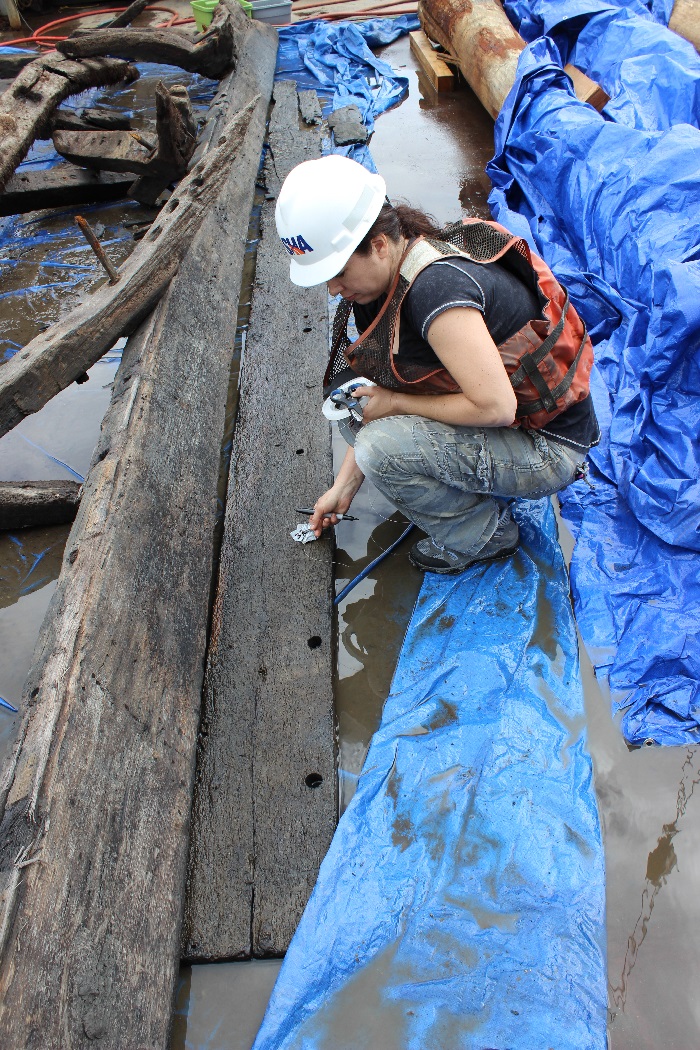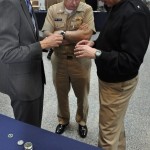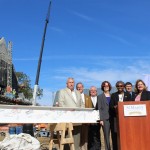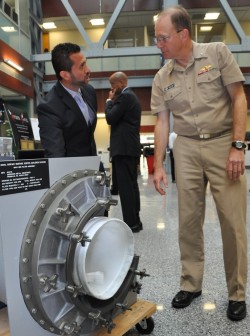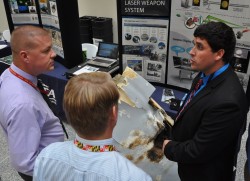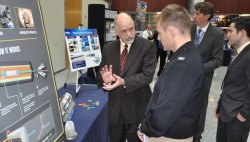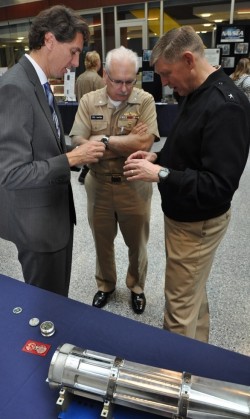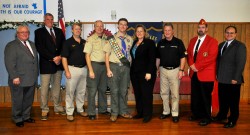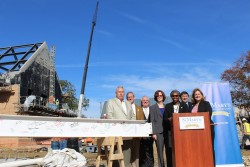Eighteenth century shipwreck discovered in the Nanticoke River
SHA photo: Dr. Julie Schablisky tagging planks from an 18th Century shipwreck in Vienna, Md.
Archaeologists Estimate Ship One of Maryland’s Oldest Ever Recovered
(August 24, 2015) – During the repair of the US 50 Bridge over the Nanticoke River, the Maryland Department of Transportation’s State Highway Administration (SHA) discovered an 18th century shipwreck in the water. SHA was removing debris from under the bridge when workers realized some of the wood may be ship timbers. The crew notified SHA’s archaeologists who found that an intact keel, frames and other ship timbers had been lifted from the river and placed on the construction barge. The team transferred the shipwreck to the Maryland Archaeology Conservation Laboratory in Calvert County for stabilization and temporary storage.
Treenails (wooden pegs) held the ship together which showed other attributes of early building including few iron fasteners. Although the shipwreck is in pieces after being raised from the 30 ft. deep water, the timber is in good condition with saw marks and curious carved symbols still visible in the wood.
The growth rings in the wood’s timber showed the ship was primarily constructed of oak cut from trees along the coastline of the central Chesapeake Bay, between the Potomac River and Annapolis. She was likely built in Maryland at a small shipyard or plantation and may represent an early stage in the evolution towards the Chesapeake Bay cargo carrying pilot schooner and eventually, the famed Baltimore Clipper. Archaeologists have determined this was a merchant ship that measured up to 45 ft in length. The 18th century construction date would make it one of the oldest Maryland built shipwrecks discovered.
“The inadvertent discovery of this shipwreck is an amazing opportunity to study early maritime history. It reminds us how Marylanders used to move goods and people across the region. It’s not every day we get to touch a shipwreck built more than 200 years ago,” said Dr. Julie Schablitsky, SHA Chief Archaeologist.
The next step is to determine what to do with the shipwreck and how to share the discovery with the public. SHA documented the timbers with a 3D Laser scanner and it is now possible to at least virtually reconstruct what she looked like before coming to rest on the bottom of the Nanticoke. How she got there is still a mystery.
# # #
Julie M. Schablitsky directs the Cultural Resources Section at the Maryland State Highway Administration. Her expertise includes historic archaeology, military sites, and transportation centered landscapes. Dr. Schablitsky’s past research includes: the Donner Party of California; War of 1812 in the Chesapeake; and John Paul Jones’ boyhood home. Currently, she is working at Amisfield Tower in Scotland and excavating an African American slave quarter in Anne Arundel County, Maryland. In addition to authoring journal and magazine articles, she has co-edited and contributed to Archaeology of the War of 1812 (Left Coast Press 2014), Importance of Material Things (Historical Archaeology 2012), and An Archaeology of Desperation: Excavating the Donner Party’s Alder Creek Camp (University of Oklahoma Press, 2011), winner of the James Deetz Book Award.
